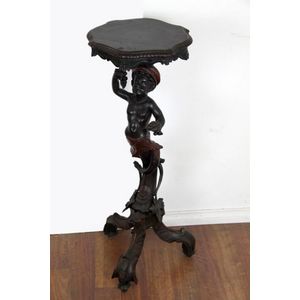Italian Walnut Putto Torchere
You must be a subscriber, and be logged in to view price and dealer details.
Subscribe Now to view actual auction price for this item
When you subscribe, you have the option of setting the currency in which to display prices to $Au, $US, $NZ or Stg.
- Putto / Putti / Amorino / Amorini - A putto (plural: putti) or amerino (plural: amerini) is a cherub or cupid frequently appearing in both mythological and religious paintings and sculpture, especially of the Renaissance and Baroque periods and later used as a decorative element in the design of furniture, ceramics, statuary etc. They are usually depicted as chubby males, or of indeterminate gender, often with wings. Their depiction may represent an association with love, heaven, peace or prosperity.
- Scrolls - Serpentine-shaped forms, used in cabinet construction and decoration for centuries. The scroll appears in legs, feet, as carving in chair brackets, chair rails and arms. The deeper and more spontaneous the carving is, the earlier the piece is likely to be. The Regency or 'Thomas Hope' scroll, used on pediments and sideboard backs, consists of two scrolls on the horizontal plane, placed back to back in a mirror image, and sometimes decorated with a variety of carved and/or applied ornament, such as shells, foliate and other motifs. Chippendale-style furniture is often distinguished by two corresponding scrolls in the form of a 'C' in the upper splat or where chair legs join the seat rail.
This item has been included into following indexes:
- torcheres 115
Visually similar items

Figured pedestal, Continental, carved with figured support, scalloped edge top and tripod base, height 94 cm

A 19th century walnut blackamoor torchere, the support of an Nubian draped figure, on scrolled feet. The shaped top with foliate decoration. 94 cm high, 34.5 cm wide.

A Venetian polychrome blackamoor occasional table the stem modelled as a cherubic figure holding a bunch of grapes, above a tripod base, 76 cm high

Games table, Victorian walnut with inlaid top spiral and beaded column tripod base and scalloped top
